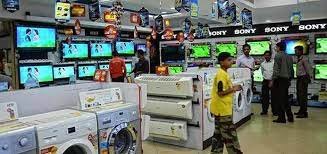The consumer durables companies in India have successfully combatted the challenges thrown upon like supply chain disruptions, downfall in demand and shortage of manpower, etc. The end-users and LSPs are now well-prepared to ensure business continuity in the long run — through various initiatives like maintaining higher inventories, technology-led service and business models, door-to-customer service, growing e-commerce, reactivation of rapid task forces, as well as measures to ensure de-risking of logistics, production, supplies and inventory levels. Besides, due to factors like pent-up demand, continued work from home, changing weather conditions — which aid sales of consumer durable products — as well as vaccination drives, sector experts say they are already seeing good demand coming.
Ritika Arora Bhola
Winning themes consumer durables companies need to consider
Keeping in mind the learnings gathered in the last one year, the consumer durable companies in India have adopted various efficient and unique strategies to move forward and achieve growth. The players expect this demand to be high in the coming few months, owing to an increased need for electrical and home appliances and interior products due to the continued work-from-home culture.
Pradeep Bakshi, MD & CEO, Voltas says, “Learning for the first and second wave, we have taken many steps in terms of material handling, tracking and storage. We are also attempting to deliver to the customer directly from the warehouses or factory. We are running operations with close coordination with our channel partners. We are also extending support to channel partners in terms of transportation in order to avoid any delay in delivery.”
“As market leaders with the highest reach in the country, we are prepared to deliver for specific channel formats, both offline and online, and have adopted a flexible approach towards fill-ins at the store level. At Voltas, we have always strived to ensure that our services remain focussed on our consumers and the nation’s needs at large.”
“Considering a very dynamic external situation outside which has a big impact on the assessment of demands, we want to ensure that the demand received is vetted and same is refined for a proper supply alignment. That means a robust Sales and Operations planning approach resulting into a demand forecasting with a high-level accuracy,” says Vidyut Kaul, Head– Personal Health – Indian subcontinent at Philips.
He underlines few other efficient strategies adopted:
- Continuous alignment with global supply chain and suppliers to ramp up production of material to meet up the demands in India.
- An optimal safety stock of all the A & B class articles mitigates the hike in the demand.
- An alignment with global service providers for vessels reaching India on time to ensure that the supplies are on time.
“India being a vast country with multiple distribution points for Philips, we look for timely arrival of shipments at the ports to ensure a further warehouse to warehouse movement and finally to the end customer which takes place within the stipulated time, and revenue too gets recognised the same month,” Kaul highlights.
As an organisation, Kaul says, they have focussed on their planning process – as is the case with most of the organisations. They say well begun is half done – it is the same approach in sales planning, a good plan is half the job – the other half is ensuring timely availability of stock and at the right location. We have stepped our effort in optimising our sales and planning process that allows our teams to deliver on our customers and our consumer needs by doing the following:
- Monitoring past data as a reference for trends and patterns
- Refining the plan together with end-to-end teams to reflect current plans and market reality
- Sharing the plan with the factories and suppliers via an end-to-end planning tool
- Giving visibility to the sales team on availability of stock for sales and sharing tracking reports for visibility and transparency
A close watch on consumer behaviour, strong scenario and risk planning is important to manage supply chains and vendors for Godrej Appliances. “We are currently relying on weekly planning, daily monitoring and a very dynamic response system to schedule production and dispatches. Continuous communication with no gaps, with all stakeholders in the supply chain is being followed for strong alignment,” says Arnab Baagchi, the company’s Associate Vice President and Head– PSI.
“We are keeping our operations lean and adjusting production as per current requirements. We are also ensuring the availability of spares at our respective branches, so that the local team is equipped to address consumer complaints, if any, on priority.”
Baagchi in general highlights two the key factors considered in optimising their supply chain operations:
- Inventory control through proximate supplier’s base, localisation of imported items, JIT supplies, following ‘make to order’ format, periodic review of inventory, minimising operating and distribution cost.
- Digitisation of supply chain for better visibility of stock/finished goods, EOL monitoring and promoting transparency for multi-level decision making.
Digital-led supply and sales channels
Over the pandemic, e-commerce contribution has doubled for most players from high single digits to mid double digits. Urban consumers are likely to demand more convenience while the semi-urban consumer is likely to demand value products with great service. Consumer durable manufacturing companies are aggressively adopting digitalisation to enhance efficiency, transparency, traceability and end-to-end visibility of shipments and overall manufacturing and supply chain processes. Adoption of sales force automation (SFA) and dealer management system is underway and will ensure analytics drive appropriate levels of stocking and reduce dead stock at dealer points. Leveraging GPS tracking for planning the optimal transit routes can further drive transportation and logistics efficiency. In fact, while most leading consumer durables firms are evaluating sales, marketing and service clouds, many have already set forth with the initiatives.
As they scale up significantly, Bakshi says, they have taken several initiatives in this direction—connecting suppliers and vendors through electronic data interface (EDI), portals which give real-time inventory and sales insights, and mechanisms capable of generating auto fulfilment of orders are some of them. “We also follow the system of E- PODs to get instant confirmation of material delivery. We have GPS-enabled vehicles to keep real-time tracking of material and their transit. We are also working on smart demand forecasting tools for a more accurate forecast. Advance WMS and TMS modules are the some of the recent initiatives we have taken recently.”
By tapping into the above levers, Kaul jots down initiatives through which Philips builds on market outreach:
- Visibility of what is available for sales and by when the new stock will arrive
- What has been sold to the customers including delivery dates
- What stock is left in the warehouse and for how long
- Balancing of stock between – regions/state/districts
“Common software for end-to-end planning of demand and supply that allows the sales as well as planning is essential. They enable us to do the following,” says Kaul.
Logistics activities and supply chains are being majorly transformed through digitalisation to eliminate inefficiencies, enhance customer service and lower costs. However, the true value of digitisation is achieved only when all operations in the supply chain are digitalised and connected, allowing for end-to-end visibility and predictive forecasting.
He shares some of the key processes implemented to embrace this transition:
- End-to-end product tracking and tracing using bar codes on every product and spare parts through a comprehensive ERP in place at factories, branches and warehouses.
- World-class CRM deployment that provides precise information on what’s moving in the market.
- Equipping factories with tracking tools to digitally inward and issue raw material for inventory accuracy and traceability.
- Sophisticated planning tools to improve forecasting and planning accuracy.
- Robotic process automation (RPA) initiatives to increase productivity and operational efficiency.
“Industry 4.0 helps in ensuring end-to-end transparency and real-time tracking. Gaps in the supply chain processes, if any, can lead to supply chain disruptions, sales loss and increase the non-value added cost. Today, digital optimisation is the key to success. We can make what the market requires through flexible manufacturing—orders can be amended in the shortest possible time, while VSM used for process optimisation and operational efficiency can be enhanced by real-time monitoring. Industry 4.0 has helped us to improve our process, operation and relationship with customers,” Baagchi says.
Efficient logistics is going to be the differentiator
Experts predict a huge surge in demand for the consumer durable products in the coming years. With e-commerce sector flourishing by leaps and bounds, door-to-door service available and supply chains becoming more tech-friendly, the growth is definite. The pandemic had actually accelerated opportunities in innovation this sector.
The demand for consumer durable products like Television, Washing Machine, Furniture, household appliances and interior products, etc. never saw a decline and in fact, customers have become more aware and are not shying away or hesitating from purchasing the products online.
- According to reports, Appliances and consumer electronics industry is expected to double to reach Rs 1.48 lakh crore (US$21.18 billion) by 2025. In May 2021, consumer durables output increased by 98.2 per cent, compared with 70.3 per cent decline in May 2020.
- Electronics hardware production in the country increased from Rs 4.43 trillion (US$72.38 billion) in FY19 to Rs 5.47 trillion (US$89.38 billion) in FY20.
- As of FY20, electronics, domestic appliances and air conditioner market in India were estimated to be around Rs 5,976 crore (US$0.86 billion), Rs 17,873 crore (US$1.80 billion) and Rs 12,568 crore (US$2.56 billion), respectively.
- According to India Cellular & Electronics Association (ICEA), India has the potential to achieve a value of US$ 100 billion in manufacturing of laptops and tablets by 2025.
- Smartphone shipments in India increased 8 per cent y-o-y to reach 152.5 million units in 2019, thereby making it the fastest growing among the top 20 smartphone markets in the world.
- The dishwasher market in India is expected to surpass US$90 million by 2025-26, driven by rising demand from metro cities such as Mumbai, Hyderabad, Delhi and Bangalore.
- According to a report by Care Ratings, consumer electronics and appliances manufacturers are set to increase their production by 5-8 per cent in FY22, after witnessing a contraction in demand in FY21.
- According to RedSeer, India’s consumer digital economy is projected to reach US$800 billion by 2030, from US$85-90 billion in CY20, driven by increase in online shopping.
Kaul says, “2020 saw a fundamental shift in consumer behaviour and has witnessed emergence of several new trends that is driving more experimentation in categories like personal grooming at home. Overall increased staying at home has re-defined the role of consumer durables in our lives. E-commerce and digital avenues have continued to be the channels which have been leveraged and have continued to perform and they can be potential channels for exploring new launches. At Philips, we expect personal grooming, cooking, cleaning and purifying appliances to do well and are investing in the same. Consumers are identifying the needs which were already there and are looking at products and solutions that can make their life easier and self- sufficient. This growth is going to sustain because these are the needs which are not going to go anywhere.”
“We believe that satisfied customers and consumers is one of the essential factors for any organisation to stay relevant and succeed over a long term. Supply chain is the backbone of any organisation and thus its role becomes more challenging when there are factors which can severely impact both demand and supply. It is important to collaborate with customers to understand the short- and long-term demand and supply projection scenario have a strong end-to-end supply chain and align with suppliers across regions which enables a continuous improvement cycle,” he adds.
“Moreover, we believe that good forecasting leads to a better accuracy in terms of maximising the efficiency for the supply chain structure which in turn ensures better fulfilment and customer satisfaction. Additionally, warehouse network optimisation is essential wherein moving warehouses to locations near customer base ensuring incurring low cost in last-mile delivery,” Kaul further explains.
“With the shift from conventional logistics to e-commerce, consumer expectations for instant or on-time deliveries have become a norm. This has boosted the logistics industry, which has become more organised as a result,” says Baagchi.
“The consumer durable logistics market is likely to grow in line with the growth expected in this sector. One step forward is the adoption of technology as an enabler for efficient, accurate, and organised mobilisation of resources. A robust logistics sector can go a long way in the quest to Atmanirbhar Bharat. Indigenisation of currently imported parts as well as the government led Make-in-India initiatives will provide the necessary push to this sector,” he aptly feels.







